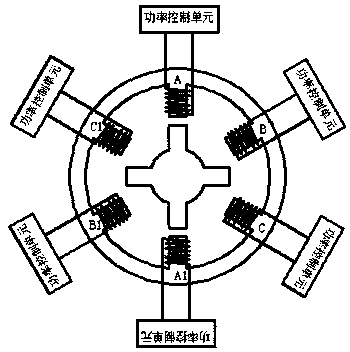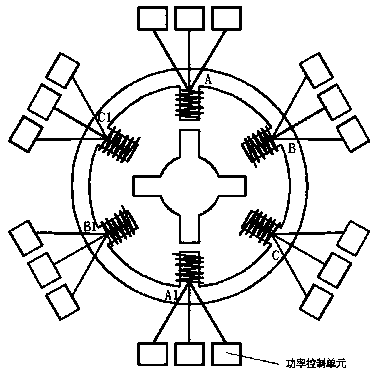Novel switched reluctance motor
A switched reluctance motor, a new type of technology, applied in magnetic circuits, synchronous motors for single-phase current, electromechanical devices, etc., can solve the problems of difficult manufacturing of power control units, high requirements for withstand voltage, and high voltage levels. Achieve the effects of improving stability and service life, reducing the demand for withstand voltage levels, and saving wiring costs
- Summary
- Abstract
- Description
- Claims
- Application Information
AI Technical Summary
Problems solved by technology
Method used
Image
Examples
Embodiment 1
[0028] The invention discloses a novel switched reluctance motor. A plurality of salient poles are arranged on the motor stator, wherein each salient pole is individually matched with a winding, and an independent power control unit 4 is connected to each winding, so that each winding is The connected power control unit 4 can individually control the power supply to this winding.
[0029] like figure 2 The three-phase 6 / 4 switched reluctance motor shown has a power control unit 4 individually connected to the winding on each salient pole of the stator, and the three-phase 6 / 4 switched reluctance motor has 6 salient poles, so the stator is connected There are 6 power control units 4, and each power control unit 4 individually supplies power to a winding on a salient pole.
[0030] Compared with the existing switched reluctance motor in the above structure, one power control unit 4 only needs to supply power to one salient pole winding, while in the prior art, one power contro...
Embodiment 2
[0032] The invention discloses a novel switched reluctance motor. A plurality of salient poles are arranged on the stator of the motor, wherein each salient pole is individually matched with a winding, and each winding is independently connected with a plurality of independent power control units 4, so that each winding is The power control unit 4 connected above can individually control the power supply to this winding.
[0033] like image 3 As shown in the three-phase 6 / 4 switched reluctance motor, the windings on each salient pole of the stator are individually connected with multiple independent power control units 4. In this embodiment, each salient pole winding is connected with 3 independent power control units 4. The power control unit 4 of the three-phase 6 / 4 switched reluctance motor has 6 salient poles, so 18 independent power control units 4 are connected to the stator, and 3 independent power control units are connected to each salient pole winding correspondingl...
Embodiment 3
[0036] The invention discloses a novel switched reluctance motor. A plurality of salient poles are arranged on the stator of the motor, wherein each salient pole is individually matched with a winding, and each winding is independently connected with one or more independent power control units 4, so that each The power control unit 4 connected to each winding can individually control the power supply to the winding; the in-phase salient poles of the motor stator are matched with each other and act on the motor rotor; the windings on the matched in-phase salient poles are independent of each other and not connected; any The power control units 4 connected to the windings on the two salient poles are independent of each other.
[0037] like figure 1 As shown, the in-phase windings of the existing switched magnetic motor are connected to each other, and the in-phase windings are connected to the power control unit 4 in series with each other. However, in the present invention, e...
PUM
 Login to View More
Login to View More Abstract
Description
Claims
Application Information
 Login to View More
Login to View More - R&D
- Intellectual Property
- Life Sciences
- Materials
- Tech Scout
- Unparalleled Data Quality
- Higher Quality Content
- 60% Fewer Hallucinations
Browse by: Latest US Patents, China's latest patents, Technical Efficacy Thesaurus, Application Domain, Technology Topic, Popular Technical Reports.
© 2025 PatSnap. All rights reserved.Legal|Privacy policy|Modern Slavery Act Transparency Statement|Sitemap|About US| Contact US: help@patsnap.com



